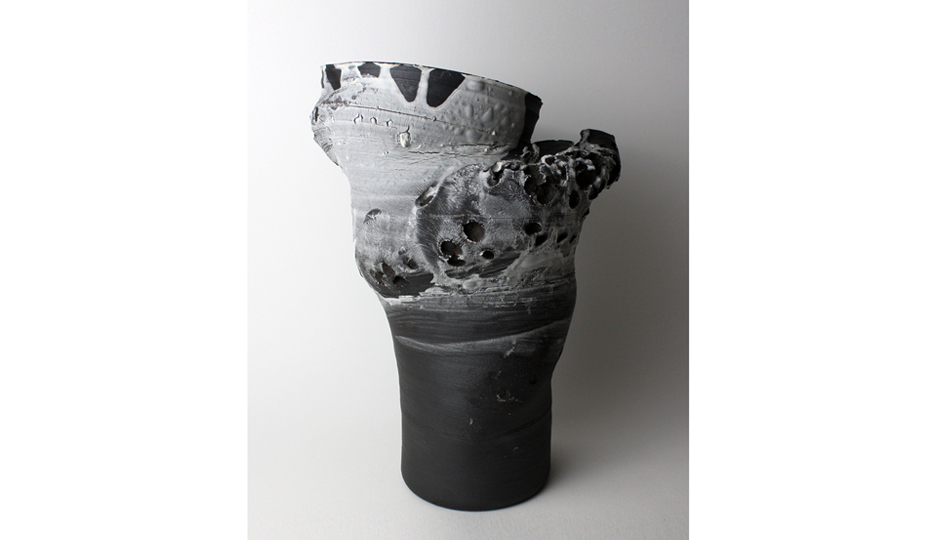
野田敏明 展「Issues from the Hands」Toshiaki Noda“Issues from the Hands”
野田敏明 Toshiaki Noda
| 会 期 | 2017年7月19日(水) - 2017年8月 7日(月) |
|---|---|
| 時 間 | 11:00 - 20:00 |
| 場 所 | 8/ ART GALLERY/ Tomio Koyama Gallery |
| 料 金 | 入場無料 Admission Free |
オープニングレセプション:2017年7月19日(水)18:00-20:00 *作家も在廊予定です
Opening reception: Wednesday, July 19, 2017 6pm-8pm
野田敏明は日本で陶芸を学んだ後、2008年にカリフォルニア州立大学ロングビーチ校、ファインアート科を卒業。現在もアメリカを拠点に、セラミックアートの制作活動を続けています。野田の作品は、陶器でありながら木の皮や岩肌、金属のような質感を持ち、水面に広がるような色の滲み、そして伝統的な日用品としての陶芸から離れた自由な造形が魅力です。全ての作品はまず左右対称の整ったフォーム成形から始まります。それから塗ったり、潰したり、破いたり、くぼませたり、幾重もの変形と破壊を繰り返して、新たな形へと生まれ変わっていきます。その姿はどこか歪ながら有機的でもあり、今地球上にある、あらゆるものが辿る変遷を思い起こさせます。
彼がモチーフに選ぶのは、日常から取り残され、見捨てられてしまったようなものです。「日常にありふれたものが時間の経過と共に、美しく不思議で独特な姿に変化した様に興味をそそられる。そして、そのもの達が経験してきたストーリーに想像を膨らませてしまう」と野田が語るように、それらは常にインスピレーションの源泉となっています。
私たちの周りにあるものは、毎分毎秒、それが誰かの手によるよらないに関わらず、小さな変化を続けています。構成と造形、変形、そして分解と破壊。時間をかけ、偶然的な要因が重なって起きるものの変化は、堆積し掘り起こされた土が、焼成され陶器に変わっていく概念そのものとも言えるでしょう。
また、野田はバケツや重なった卵パックなど容器としての実用性を持っていたものや、ロクロで作られた一輪挿し、お椀といった陶芸の伝統的な形を変形、融合するようなアプローチも試みています。そこには、日用品として発達した陶器の持つ概念や歴史を捉え直そうとする野田の姿勢が伺えます。彼のバックグラウンドに陶磁器で有名な有田があることからも、その歴史に対する批評的な眼差しが常に野田の中にあるのでしょう。こうした繰り返しの中で粘土と向き合う時間、過程、成形中の瞬間ごとの意図、その意図に対する粘土特有の反応などの記録がランダムに折り重なっていく野田の作品は、新たな陶器の可能性を示唆すると同時に、伝統的な陶器とは何か、陶芸とファインアートの境界や装飾品と彫刻との境界を問いかけます。
日本では初の個展となる本展は、2012年から2016年にかけて制作されたセラミック作品を展示いたします。テクスチャー、ひび、破れ、滴り、くぼみ、溝、自然な曲線、層の重なり。いくつもの要素が絡み合う作品は、これまでの野田の作品から更に、時間の経過がものに与える美しい影響そのものに焦点が当てられています。私たちはその抽象的な姿に、例えば地層の重なる山肌のような自然のランドスケープや植物、ぼろぼろに古びた人工物や遺物などを見出すでしょう。あるべき姿からの解放と自由な展開が観る者を魅了します。野田の手から生まれる時間の結晶を、この機会にぜひ、ご高覧ください。
野田敏明は1982年佐賀生まれ。佐賀県立有田工業高校セラミック科を卒業後、渡米。カリフォルニア州立大学ロングビーチ校を卒業しました。その後、ニューヨーク州ロングアイランドシティのブリックハウス・セラミックアートセンターでのアソシエイトや、ジェフ・クーンズ・スタジオでのアシスタントを経て、2015年から現在までは、スカルプチュアスペースNYCで制作活動を続けています。カリフォルニアとニューヨークを中心に毎年個展やグループ展を開催し、作品はルイ・ドレフュス財団コレクションにも収蔵されています。
After studying ceramics in Japan, in 2008 Toshiaki Noda graduated from California State University, Long Beach (BFA). He currently lives in the United States and works with ceramic art. Noda’s ceramic work embraces textures that recall tree bark, rock surfaces, or metal, bleeding colors together as if on the surface of water, and forms liberated from the functionality of traditional everyday ceramics. All his works start with creating symmetrical forms. The artist then adds layers, smashes, tears, and dents, turning them into new forms after multiple layers of changes and destruction. The completed work is distorted yet looks organic, reminding us of the transitions which all creatures on earth have undergone.
Noda chooses motifs that have been left behind, or abandoned in daily life. As Noda states that “(he is) interested in the ways in which ordinary things change into beautiful, mysterious and unique states as time goes by. I cannot help imagining the stories that they experience." These are the artist’s constant sources of inspiration.
All things surrounding us, regardless of the presence or absence of human intervention, are continuously undergoing small changes at every second. Construction and creation, transformation, and division and destruction. Changes occur by through the accumulation of multiple incidental factors over time, which suggests conceptual associations with the accumulated and dug-up soil that is fired and then turned into ceramic.
Noda also experiments with approaches to transforming conventional ceramic forms such as flower vases and tea bowls, and combining them with functional objects including buckets or stacked egg cartons, suggesting his attempts to recapture the concept or history of ceramic ware that has developed as a daily commodity. He has developed critical perspectives towards the history of ceramic, perhaps under the influence of the famous ceramic production area of Arita, which is the artist’s hometown.
Noda’s work takes shape with many layers: the time spent with the clay, his intention at every moment during the process of formation, and the documentation of specific reactions by the clay towards the intention, suggesting the new possibilities of ceramic, as well as questioning traditional craft and the boundaries between ceramic and fine art, decoration and sculpture.
This is Noda’s first solo exhibition in Japan, and features his ceramic works created from 2012 to 2016. Texture, cracks, ruptures, drips, hollows, gaps, natural curves, and layers. These works with multiple complex elements speak about the beautiful effects of time upon objects. We may find within them natural landscapes with layered mountains and plants, ragged artifacts, or relics. His work is a crystallization of time, and attracts the viewer by liberating ceramic from what it “should” be.
Toshiaki Noda was born in 1982 in Saga, Japan. After graduating from the Ceramic course of Arita Technical High School, he moved to the United States, and graduated with a degree in printmaking from California State University, Long Beach. After working as an associate at BrickHouse Ceramic Art Center in Long Island City, New York, and as an assistant to Jeff Koons, he has worked at the Sculpture space NYC since 2015. He presents work both in solo and group exhibitions in New York and California, and his work is collected by the William Louis-Dreyfus Foundation.








